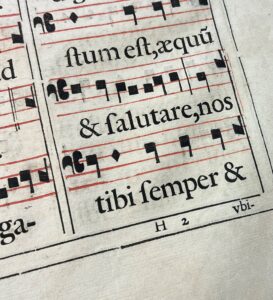 By Emma Laws, Cathedral Librarian
By Emma Laws, Cathedral Librarian
If you look in the lower-right corner of each page of a book printed between the 15th and 18th centuries you will usually spot a word, or part of a word, that anticipates the first word of the following page. These words and half-words, situated outside the main text, are called catch-words and they helped the person assembling the book to fold and sew the loose pages together in the right order. You will likely see other clues, too. Printers assigned each page (leaf) of the book a unique code, or signature, usually a letter or letters followed by a number; for example, A, A2, B, B2 or Aa, Aa2, Bb, Bb2, etc. These signatures, printed at the bottom of pages, provided additional clues to assembling the pages in the right order. Even in our modern world, books remain familiar, everyday objects. We may not think of printed books as objects of art and design, but for centuries they were hand-printed and hand-crafted and by deciphering clues within books, such as catch-words and signatures, we can understand how they were printed, assembled and bound.
Heritage Open Days (8-17 September) is a national annual festival of history and culture. To celebrate this year’s theme of Creativity Unwrapped, we are offering unique opportunities to delve behind the scenes and look more closely at some of the Cathedral Library’s most beautiful hand-printed books, including the Nuremberg Chronicle, King James Bible and Sarum Missal, and ground-breaking works of science and natural history, such as John Gerard’s Herball, Galileo’s Systema cosmicum, and Robert Hooke’s fabulously illustrated Micrographia. Workshops are free: find out more and book your place here.